February 13th, 2017 by Stephanie Uz
Trying to sleep on a trampoline while somebody is jumping on it – this is how it feels during many nights at sea as the ship zig-zags in an imaginary box around our drifting instruments in the North Pacific during winter. This is when biological activity is lowest, but clearly there is no absence of physical forces, such as waves. Clearly.
The aim of this expedition is to find phytoplankton and measure their characteristics using light detectors, cameras and microscopes. From my perspective as an oceanographer who uses satellite data to explore large scale physical forcing of biology, this is a great chance to think about the smaller-scale forcing mechanisms that supply nutrients to the phytoplankton. And I am glad to get acquainted with the optical and biological instruments and methods being used and tested here at sea.

Hemispheric view by Suomi-NPP VIIRS on Feb 9, 2017 in true color. Clouds and airborne particles are white; ocean, blue. The ship’s track is shown in the red line. Station M is our last sampling site. NASA/ Norman Kuring
Slow Water, Low Biology
We began the campaign near Hawaii at the end of January in the North Pacific subtropical gyre, which has a predominate slow-moving circulation pattern that causes nutrient-depleted surface water. We experienced plenty of swell from distant storms – lab equipment had to be tied down, and chairs slid across the galley. Still, nutrient-rich deep water remained far below the well-mixed surface waters.
The water was exceptionally clear. Sunlight penetrated deeper than 150 meters (500 feet). In spite of the dearth of nutrients, our imaging systems revealed some phytoplankton! They appeared malnourished, but surprisingly diverse nonetheless.
In the absence of strong currents or other flow patterns, the Wirewalker instrument drifted westward making daily clockwise loops with the Earth’s rotation. I was excited to see its path mapped with inertial oscillations so clearly visible. Although they are always present, it is rare to see them this obviously as they are usually hidden by stronger forcing.
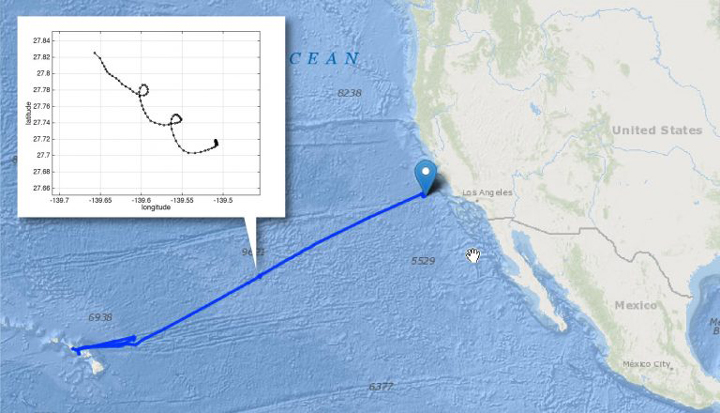
A plot of the Wirewalker’s track as it drifted freely at our second site for three days. Each point in the plot represents one hour. SOI/ Melissa Omand
Fast Water, More Biology
The end of our sampling campaign is approximately 250km (150 miles) west of central California over a site called ‘Station M.’ This location is typically more productive, being in the California Current that brings cooler water southward from the subpolar gyre.
Additionally, we arrived between low pressure frontal systems that have been pummeling the west coast with strong winds, rain and snow over the past month. These strong weather systems cause wind-mixing at the surface of the ocean, bringing nutrients up from depth. Sampling revealed a warmer, fresher top 30 meters (100m) above cooler, nutrient-rich water.
Immediately, the instruments monitoring phytoplankton and nutrients began registering significantly higher quantities than anything we saw earlier in the expedition: even more diverse and even more abundant. Collectively, this team has gathered an amazingly rich data set of measurements and images that makes the discomfort of sleeping on a trampoline all worth it.
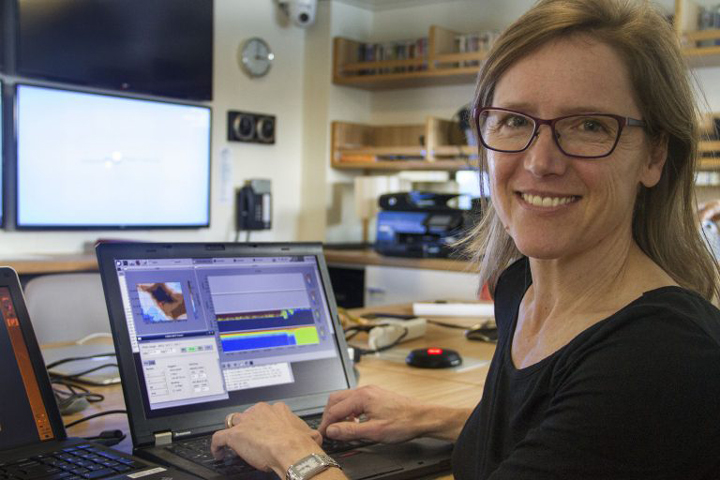
Stephanie Schollaert Uz monitors the speed and direction of water flowing under the ship with the Acoustic Doppler Current Profiler. SOI/ Monika Naranjo Gonzalez
February 11th, 2017 by Ryan Vandermeulen
Act 1: Blowin’ in the wind
At the unholy hour of 0400, I find myself on the aft deck of the world-class research vessel Falkor, bubbling with excitement stemming from a unique combination of four shots of espresso, generally being a morning person, and, most importantly, preparing to test an experimental device that I have put my blood, sweat, and tears into. As I bear-hug my newly collected bucket full of seawater on the rocking transit back to the wet lab, I take a moment to silently congratulate myself on the superb display of stamina and posture; it appears that my sea legs have finally decided to make an appearance. The sun will be coming up soon. It’s a Bob Dylan kind of day. Time to turn up the music and get to work.
Act 2: There ain’t no party like a plankton party

Ryan Vandermeulen, optical oceanographer, is testing this instrument at sea for the first time. The experimental “photosynthetron” (a.k.a. electro-squid 4000) serves as an incubation chamber for seawater samples. SOI/ Vandermeulen
In addition to being an eclectic lab DJ, one of my roles as a scientist aboard this righteously amazing research vessel is to investigate the rates of biological activity among microscopic communities within the ocean. The invitees to this epic microbial festival include bacteria, viruses, zooplankton, larval fish, and phytoplankton (algae). The photosynthetic members of this microscopic plankton community (PHYTO-plankton) are the base of a complex ocean food web, and have a large cascading ecological impact on the abundance and diversity of fisheries that we depend on. In addition, phytoplankton play a significant role in the global cycling of carbon, as well as the production of oxygen we breathe. Just like the plants in your garden, phytoplankton utilize carbon dioxide and micronutrients in the seawater – along with various light harvesting pigments which capture sunlight at different wavelengths – to create new cell bodies.
A byproduct of this magnificent life-giving process of photosynthesis is the production of oxygen, which we measure with great precision as a proxy for the amount of carbon that has been fixed into organic matter. The remaining (non-photosynthetic) members of this microbial party are not particularly polite dinner guests and have a tendency to exploit the kindness of our fearless photosynthetic community by eating the food that the phytoplankton have dutifully prepared, namely themselves (phytoplankton bodies) along with their subsequent secretion of dissolved organic matter (zooplankton are quite the sloppy eaters). We measure this microscopic massacre in the form of oxygen consumption, because, like us, these microbial heterotrophs need oxygen and organic matter that phytoplankton produce in order to live. Collectively, the ocean acts as one breathing organism as this process plays out, silently taking in copious amounts of carbon dioxide from the atmosphere and giving us oxygen that we breathe. This balance (or lack thereof) of carbon/oxygen uptake versus production lends us insight into the overall health or metabolic status of an ecosystem, in a way similar to taking the pulse of your body.

The Various light levels of the photosynthetron simulate different light conditions through the day, and the subsequent oxygen production/consumption is measured using optical sensors. SOI/ Vandermeulen
Act 3: Some telescopic insights into microscopic processes
One of the more confounding elements of studying oceanography is dealing with the fact that many measurements only tell us something about one very specific time and place in a very large and dynamic ocean. So, in addition to these experiments, we are monitoring the “color” of the ocean with continuous underway measurements of the reflectance of sunlight from the water. As sunlight hits the ocean, phytoplankton are capturing some of this light for photosynthesis, and they imperceptibly change the color of the water as light scatters back from the sea. Out in this near-barren desert of photosynthetic activity, we use a very precise radiometric measurement of over 100 wavelengths across the ultraviolet/visible spectrum to detect these subtle changes. As a NASA scientist, my other research life consists of using data from ocean-observing satellites that monitor changes in the color of the ocean over the entire globe every day. By understanding more about the link between biological activity that I’m measuring in the lab, the types of phytoplankton in the water, and how this changes the color of the ocean, we can refine how we monitor these processes from space, and thus increase our understanding of carbon cycle dynamics on a global scale. Just to re-iterate, we are literally monitoring the activity of microscopic organisms that are too small to see with the naked eye with a telescope orbiting our planet at over 15,000 mph to study climate scale processes. I think that’s pretty neat.
Act 4: Some microscopic insights into life, the universe, and everything
It’s been a long day, so I am going to wind down, grab my guitar, and serenade the sunset. They say if you sing to plants, they grow better, so there is some scientific merit to this ritual, mind you. Incidentally, our artist-at-sea, Kirsten, has inspired me through one of her onboard art + science seminars to try and take a more careful and purposeful look at the world around me. I will temporarily suspend the thought of Rayleigh scattering and radiative transfer equations as I watch the sun’s rays extend across the horizon. For now, I’ll just listen and observe.
February 9th, 2017 by Mónika Naranjo González
As an undergraduate student, Colleen Durkin had no idea what to specialize in, but looking at a seawater sample through a microscope during a field-trip to Friday Harbor Labs changed that forever. “I suppose I had used a microscope before, but I can’t remember it,” she shares. “All I know is that to this day, I can recall what that particular sample looked like, with all of its copepods and cells swimming around.” Colleen has never looked back: since then plankton has been the driver of both her career and curiosity from Undergraduate to Doctorate in Oceanography.
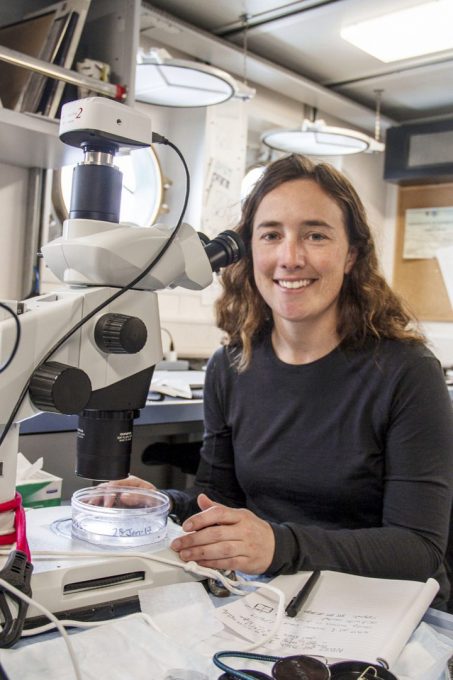
Colleen Durkin, Oceanographer, is studying particle size and distribution in order to relate it to the carbon cycle and the capacity of the ocean to store carbon. SOI/ Mónika Naranjo González
Diatoms
Diatoms are Colleen’s favorite phytoplankton, with good reason. Not only are they tiny yet incredibly complex, they are also beautiful organisms. Diatoms are capable of creating a glass shell, which bestows an almost fantastical quality upon them. “The glass has nano-scale structures,” says Colleen as she examines the image of a star-like cell. “They look like a work of design, like art.” Beyond their evident beauty, diatoms have a monumental impact on everyday life on planet Earth.

In order to synthesize silica (glass), diatoms carry out complex chemical processes, absorbing silicon available in the water. SOI/ Colleen Durkin
Take a Breath and Thank Plankton
One out of every five breaths taken by any (and every) life form on the planet comes from a diatom. Diatoms are a kind of phytoplankton: that is, microscopic plants drifting in all bodies of water. They carry out photosynthetic processes, ultimately producing oxygen in the air we breathe.
Half of the oxygen available to us has been produced by phytoplankton – this means that every other breath comes from microscopic organisms in the ocean. Getting to know them better, their processes, their current status, and how a changing climate will affect them is essential to us, because they are essential to life.
Although scientists have a general idea of the kinds of phytoplankton that can be found in different regions of the world at certain periods of the year, they do not yet have a complete understanding of phytoplankton communities’ full distribution. Furthermore, there is still much to be learnt about the chemical processes each planktonic group carries out. Falkor’s current expedition will help contribute to creating a baseline, connecting diversity with the processes each organism is responsible for. Humans are changing the Earth rapidly, and we need to be able to monitor and understand ocean communities before long-term changes occur.
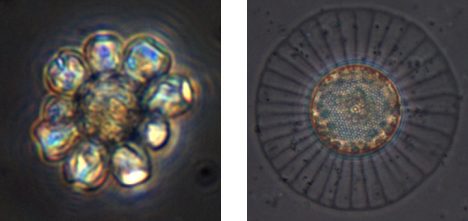
The specific chemical processes carried out by phytoplankton still need to be determined and studied. This is a microscopic picture of a coccolithophore (left). Diatoms (right) form silica shells. The reason behind this is still to be determined. One theory relates to protection from predators. SOI/ Colleen Durkin
Sea to Space
This Sea to Space Particle Investigation will allow an unprecedented view of ocean processes by using tools both in the ocean and satellites in the sky. Looking at the ocean from specialized satellites it is possible to detect colors, which help inform the presence of certain types of particles drifting in the water. This expedition will provide key information connecting the satellites’ data capturing with real time in-situ measurements. As a result, experts will improve algorithms for these satellites, allowing for better global estimates of oceanic biochemical processes.
Phytoplankton is a major foundation to nearly all known forms of life. It produces oxygen, regulates the climate and sustains the marine food chain – a fundamental source of protein for humans. At the same time, when these organisms sink, they drag carbon down to the depths of the oceans with them, counteracting the accumulation of carbon dioxide in the atmosphere. This is Colleen’s primary interest: carbon export from the air to the ocean. She knows she will never grow tired of studying phytoplankton, immersing herself in the fascinating chemical labyrinth that these creatures build – often out of sight.
February 7th, 2017 by Benjamin Knorlein
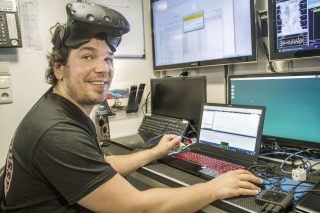
Benjamin Knorlein is a Computer Scientist from the Center for Computation and Visualization from Brown University, he is working on the design of software that will enable scientists to study plankton through virtual reality.
Every great ship needs a Holodeck. Not for entertainment, but for science. Star Trek‘s fictional Holodeck can create matter virtually (in our case, it would be scientific data) which can be seen, touched and interacted with. Unfortunately, real technology is not as advanced as we know it from TV, so for now we skip the touch. But there is already a lot we can do within Virtual Reality to immerse ourselves in the data we collect by seeing and interacting with it in a virtual world.
What do we need to get the Falkor ready for exploration?
- Get a commercially available Virtual Reality system and install it in the science control room – Check.
- Acquire data. Lots of data. And then even more data. – Check. Check. Check.
- Step into the virtual wonderland of science – Beam me up, Scotty!
Become a Phytoplankton
On board we have holographic microscope. (Yes, holographic!) In contrast to a normal microscope, the recorded holograms can refocus the microscopic image at different distances to the camera. So instead of a normal image, we acquire three-dimensional information about the location of phytoplankton in the water column. By using the the high-performance computers onboard Falkor, combined with algorithms I wrote, we can identify the kind of phytoplankton we are looking at and know its size and its location. When we plug the data in Virtual Reality, we can wander in the phytoplankton universe and see how the little organism organize themselves in the water. Scientists – who usually stare at a screen looking at phytoplankton for hours – can suddenly become part of the world they study so hard, thereby developing new perspectives, including the perspective of a phytoplankton.
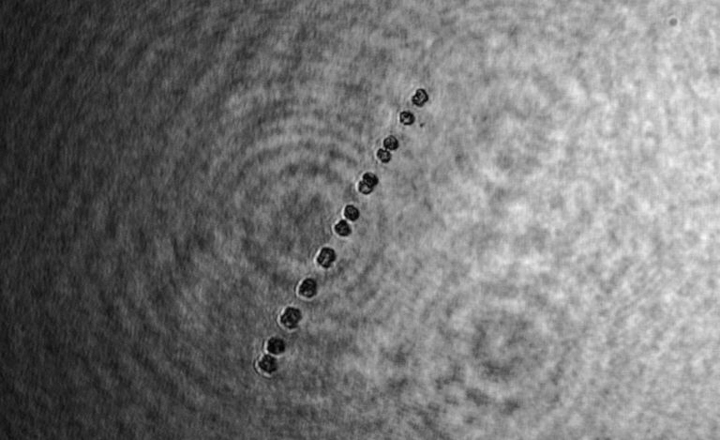
This is a holographic picture of a Diatom Chain as it looks when it is captured by the camera that descends together with the CTD Rosette.
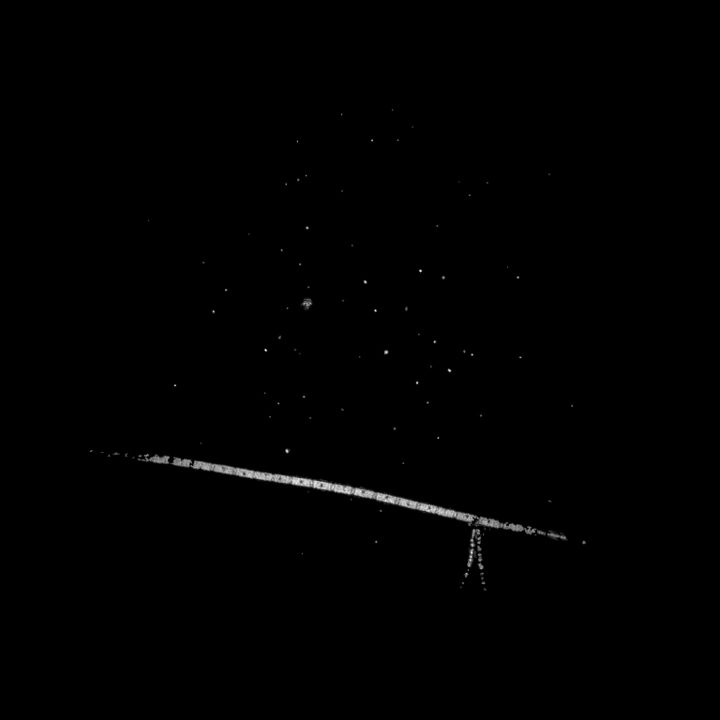
This image merges all of the plankton organisms found in a drop of water the size of a needle’s head. The image is now ready to be processed to become part of a virtual reality environment.
Take a Hike on the Seafloor or Enter the Twilight Zone
The R/V Falkor has two high resolution multibeam echo sounders. The sonars use sound to identify seafloor features in 3D. By plugging the data into Virtual Reality we can walk on the seafloor and become geologists of the ocean.
A lot of our equipment on board samples and records data in the twilight zone of the ocean – the region below the sunlit surface. The ‘wire walker’ is an instrument currently being used by the experts here – it moves up and down on a wire 150 times a day, measuring data such as temperature, salinity, pressure, oxygen, fluorescence of the phytoplankton, sunlight, and turbidity. Quite a busy explorer, this wirewalker. Taking this data combined with its GPS reporting and plugged into the Virtual Reality we can explore the depths of the ocean where no one has gone before.
Virtual Reality and New Scientific Possibilities
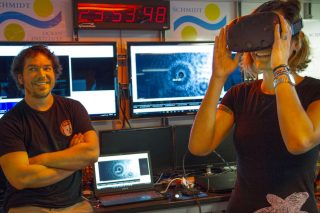
As the Sea to Space expedition progresses, on board personnel on board enjoy immersing themselves in the plankton communities collected through holographic cameras through virtual reality.
As you can see, Virtual Reality offers new possibilities to interact with scientific data. The experience is often more personal and helps to develop a different relation with the data as we coexist with it in the same world. We are suddenly not separated from it by a computer screen, but can enter its universe. We can shrink to the size of phytoplankton or we can walk deep in the oceans. We can create and modify matter and can interact with the target of our research not by using a mouse or keyboard, but by using natural interactions, e.g. we simply move our head or walk around to see the data from different perspectives.
We might also play a round of minigolf or draw phytoplankton in 3D. All, of course, for pure science.
February 3rd, 2017 by Melissa Omand

Melissa Omand, physical oceanographer, collaborated with Kirsten Carlson, Artist at Sea participant, to create a watercolor explaining the linkage involved in the Wirewalker’s whole assemble.
I have sailed with my share of compelling characters since I began ocean research, and perhaps it is fitting that while we study ocean color aboard the R/V Falkor, I have had the pleasure of getting to know one of the most colorful. Kirsten Carlson has joined the cruise as an artist-in-residence, bringing her zany, insightful perspectives and boundless energy to coax us from our laptops. Last night she encouraged me to try out her Artscipaedia Plankton coloring booklet. That is right – plankton – as in the microscopic organisms that color the ocean… exactly what the scientists are studying onboard. As it turns out, Kirsten has a background in marine science, and is a self-described plankton rescuer!
Colorful Shipmates
While coloring, I found my thoughts drawn back to the instrumentation I had released over the side the day before. My Wirewalker and sedimentation traps were miles away from our ship, drifting in the open ocean, collecting data and doing their thing… I hoped. I decided to draw the Wirewalker instrument array. I have spent months preparing for this cruise – testing the sensors, communications, preparing the sediment tubes, and making sure each piece of hardware is accounted for. I discovered I knew it by heart. Kirsten shared her watercolor paper and we devised a plan to collaborate – I would draw and she would paint. I can’t recall finding such catharsis on a cruise before. As the rest of our science party started a movie in our de facto hang-out space – alibrary/office/lounge/video conference room that has quickly become the center of orbit onboard the ship – I did my best to dust off an artistic identity I’ve rarely assumed since I was a visual art major in in high school.
Beauty in Buoys and Shackles
Drawing the mundane but critical details of each linkage in the array, I newly appreciated the elegant design of the Wirewalker: a design evolution I had observed since shortly after its invention by Dr. Rob Pinkel’s group at Scripps Institution of Oceanography. The Wirewalker is assembled in distinct segments. At the top, is a GPS-tracked buoy, and beneath this hangs a 3/16” stranded wire that stretches 150 m beneath the surface. As the buoy tugs the wire up and down over the waves, the sensor-laden Wirewalker uses a simple cam mechanism to rectify the wave action into a one-way motion down the wire. When it reaches the bottom, it hits a stop and releases it’s grip, gliding freely along the wire to the surface. This cycle is repeated every 10 minutes or so, giving us a remarkable high resolution view into the physical and physiological variations of the plankton and particles in the upper ocean.
Having a professional artist on-board (in addition to a number of talented crew and fellow scientists) has been a unique experience and has inspired me to reconnect with my inner artist. As I write this, I only hope that our collaborative art is an homage, and not an obituary to my lonely Wirewalker adrift amongst the enormous waves of the wintery North Pacific Ocean.
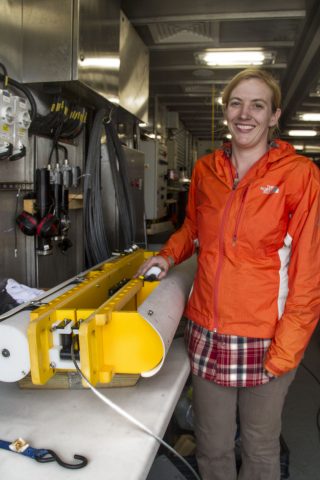
Melissa Omand will be working with Meg Estapa and Colleen Durkin to study the data collected by the Wirewalker’s assemble in order to understand Carbon Pump in these waters.

















